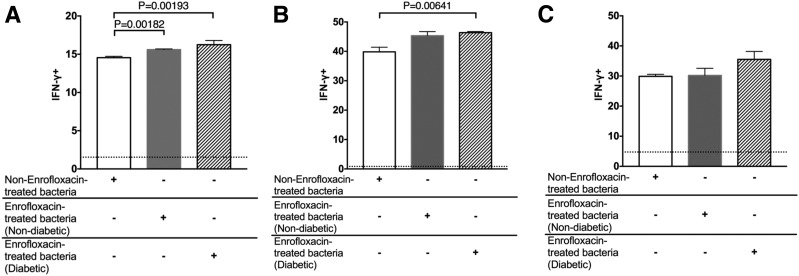Figure 6.
Effect of culture of G9Cα−/− NOD mice splenocytes with small-intestinal bacteria from untreated or enrofloxacin-treated A22Cα−/−PI2−/− NOD mice. Intracellular IFN-γ was measured in CD8+ T cells (gated from TCRβ+CD19−CD4−) (A), CD11b+ cells (gated from TCRβ−CD19−IAg7+CD11c−F480+) (B), and CD11c+ cells (gated from TCRβ−CD19−IAg7+CD11b−F480−) (C). Average baseline levels of splenocyte IFN-γ–producing cells, cultured without bacteria, which were similar in all treatment groups, are shown by the dotted line. The labeling beneath the graphs represents the origin of the bacteria: bacteria from non-enrofloxacin-treated mice are labeled as non-enrofloxacin-treated bacteria, bacteria from nondiabetic enrofloxacin-treated mice are labeled as enrofloxacin-treated bacteria (nondiabetic), and bacteria from diabetic enrofloxacin-treated mice are labeled as enrofloxacin-treated bacteria (diabetic). All splenocyte cultures with bacteria displayed significant differences from those without bacteria. All data were pooled from two independent experiments (n = 6/group). All data were assessed for statistical significance using multiple Student t tests corrected using FDR. Data are presented as mean ± SEM.

